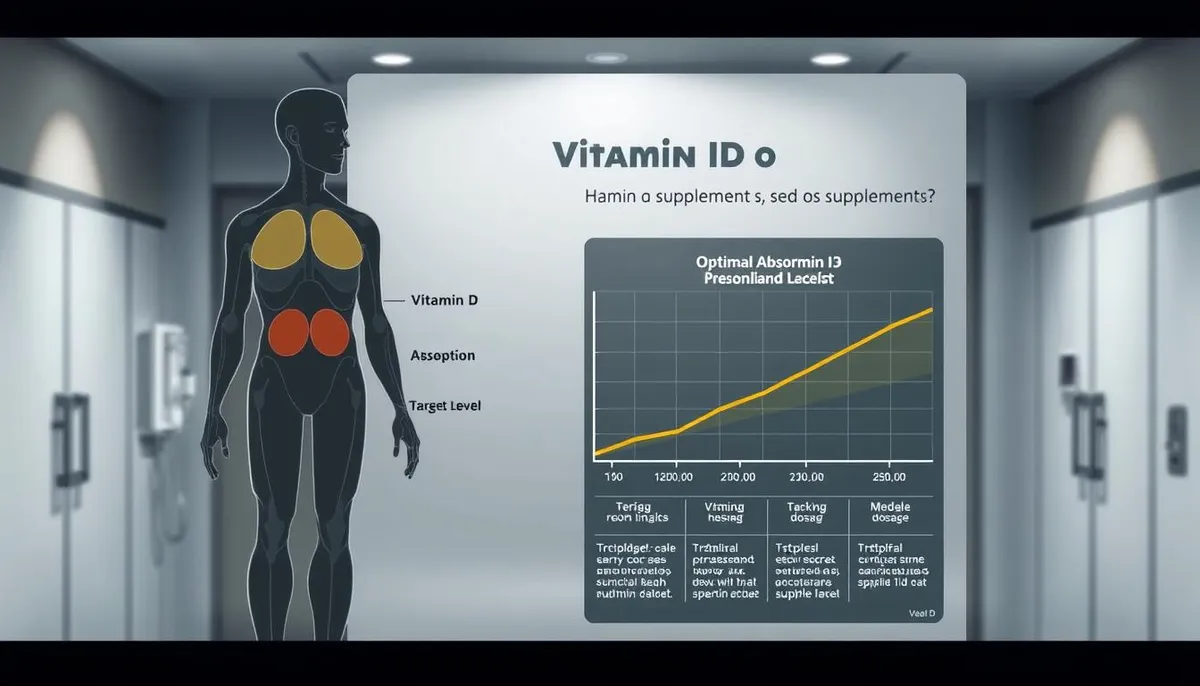Welcome to your guide for unlocking your full life potential. This journey explores the powerful role of a crucial nutrient in supporting overall wellness and longevity. Inspired by forward-thinking approaches to health, we’ll dive into evidence-based strategies.

Often called the “sunshine vitamin,” this nutrient is naturally produced by our bodies. Yet, modern indoor lifestyles can make achieving optimal levels a challenge. Understanding your personal needs is the first step toward a successful plan.
This guide provides clear, actionable information. We’ll cover dosing strategies, testing protocols, and how to integrate this practice with a healthy lifestyle. It’s not just about taking a pill; it’s about creating a sustainable approach for your unique body.
Our goal is to make complex science accessible. You’ll find credible, evidence-based recommendations to support your bone health, immune function, and long-term wellness goals. Let’s begin this exploration together.
Key Takeaways
- Personalized assessment is essential for determining the right approach.
- Baseline vitamin levels, lifestyle, and age are key factors.
- Modern life often creates a need for additional support.
- Effective strategies combine dosing, testing, and healthy habits.
- The ultimate goal is sustainable support for bone and immune health.
- This guide offers science-based information for your wellness journey.
Understanding the Role of Vitamin D in Longevity
Achieving a long, vibrant life is closely tied to the foundational support our body’s systems receive. This essential nutrient plays a starring role in this process, acting as a key regulator for numerous functions.
Its influence extends far beyond a single area, creating a network of support that promotes overall wellness as we age.
Vitamin D and Bone Health
The most well-known job of this nutrient is building and maintaining strong bones. It enables your body to properly absorb calcium, magnesium, and phosphate from the food you eat.
It also maintains a critical balance of calcium between your bones and blood. Without enough of this compound, the body must pull calcium from bones, weakening them over time.
This can lead to serious conditions like osteoporosis in adults, making bones fragile. In children, a severe shortage can cause rickets, affecting proper growth.
Impact on the Immune and Nervous Systems
The benefits reach much further than the skeleton. This compound is vital for a robust immune system, helping your body’s defenses fight off infections effectively.
It also supports a healthy nervous system, aiding in nerve signal transmission and brain function. Research suggests good levels may help protect against neurodegenerative conditions.
Emerging studies even link optimal status with a lower risk for heart disease, certain cancers, and type 2 diabetes. Optimizing your levels is about supporting your entire body for a healthier, longer life.
how long to supplement vitamin d: A Comprehensive Guide
The timeline for achieving optimal wellness depends heavily on your starting point and individual body chemistry. Your initial status, the dosage you use, and how well your body absorbs the nutrient are all critical factors.
Here is some encouraging news. Positive changes can begin very quickly. Research indicates that serum concentrations often start to rise within just three days of beginning a regimen.
Significant, measurable improvements are typically seen within ten days for most individuals. This quick response is a positive sign that your plan is working.
Correcting a significant shortfall, however, requires a more sustained effort. Transforming a deficient state into an optimal range generally takes about ten weeks of consistent daily use.
The standard recovery period for most people is approximately six to eight weeks under medical guidance. The exact time varies based on the severity of the insufficiency.
| Phase | Typical Timeline | Key Objective |
|---|---|---|
| Initial Response | 3-10 days | Serum concentrations begin to rise measurably. |
| Deficiency Correction | 6-10 weeks | Raise levels from insufficient to the normal range. |
| Long-Term Maintenance | Ongoing | Sustain optimal concentrations for lifelong health. |
Once you reach your goal, the journey isn’t over. Maintenance is often necessary to prevent a drop back into suboptimal ranges.
For many adults, sustaining healthy serum concentrations may require a daily intake of 2,000-3,000 IU. Your personal needs can differ based on weight, skin tone, location, and lifestyle.
It is essential to work with a healthcare provider. They can determine your personalized timeline and dosage based on blood test results, ensuring a safe and effective strategy for you.
Determining Your Individual Vitamin D Needs
No two people have identical nutritional requirements, making individual assessment essential. Your personal vitamin need depends on various lifestyle and biological factors.
Assessing Dietary Intake and Sun Exposure
Start by evaluating your regular food choices. Look for fatty fish, egg yolks, and fortified dairy products in your diet. Many people may need supplements if these foods aren’t common in their meals.
Sun exposure patterns also matter significantly. From April to October, 15-30 minutes of midday sun can help your body produce adequate amounts. During colder months, sunlight becomes less effective at northern latitudes.

Factors Influencing Vitamin D Requirements
Several conditions increase how much vitamin D your system requires. Age over 65, darker skin pigmentation, and higher BMI affect your body’s ability to produce and use this nutrient.
Medical history plays a crucial role too. Digestive conditions like Crohn’s disease or celiac disease can reduce absorption. Certain medications may interfere with how your system processes this compound.
Discuss your complete health profile with a healthcare provider. They can determine if you may need supplements and recommend the right amount vitamin D for your situation.
Effective Vitamin D Supplementation Methods
Modern nutritional science offers several effective ways to get your daily nutrients. The format you choose can influence how consistently you take them and how well your body absorbs them.
Choosing Between Oral Sprays and Pills
You’ll find two main types of these vitamin supplements available. Ergocalciferol (D2) typically requires a prescription. Cholecalciferol (D3) is available over-the-counter and appears more easily absorbed.
Oral spray technology provides a convenient alternative to traditional pills. These products deliver nutrients directly into your bloodstream through the mouth’s lining.
This method bypasses the digestive system entirely. It’s ideal for people with absorption issues or difficulty swallowing pills. Sprays offer potentially faster uptake compared to tablets that need digestion.
Both delivery systems can be effective when used consistently. Your choice depends on personal preference, lifestyle, and any digestive considerations.
Understanding Dosage and Supplement Strengths
These products come in various strengths to meet different needs. Adults with significant needs might use 3,000-4,000 IU formulations. Maintenance doses around 1,000 IU work well for most teens and adults.
Children and infants typically need lower doses around 400 IU. Vegan options derived from lichen are also available for plant-based diets.
The most effective way to supplement is the method you’ll use consistently. Consider ease of use, taste preferences, and cost when selecting your vitamin supplements.
How to Test and Monitor Your Vitamin D Levels
Knowing your numbers is the first step toward optimizing your health. Regular monitoring provides objective data that transforms guesswork into evidence-based decisions.
Healthcare providers use a simple blood test called 25-hydroxyvitamin D to assess your vitamin status. This measurement reflects your body’s reserves and provides the most accurate picture.
Interpreting Blood Test Results
Results are typically reported in nanograms per milliliter. Understanding these numbers helps you track progress effectively.
Most healthy people maintain adequate vitamin levels at 20 nanograms per milliliter or above. A reading below 12 nanograms per milliliter indicates deficiency.
| Deficiency Category | Level (ng/mL) | Typical Approach |
|---|---|---|
| Mild | Less than 20 | Moderate supplementation |
| Moderate | Less than 10 | Higher dosage regimen |
| Severe | Less than 5 | Medical supervision needed |
Levels above 50 nanograms per milliliter may be too high. This could potentially cause health issues.
At-Home Testing Options
Convenient at-home test kits are now widely available. These allow you to check your vitamin status without visiting a clinic.
Always discuss your results with a healthcare provider. They can help interpret the numbers and create a personalized plan.
Establish a testing schedule with your provider. Start with a baseline test, follow up after 6-8 weeks, then monitor periodically.
Integrating Supplementation with a Healthy Lifestyle
Creating a truly effective wellness strategy involves more than just taking a daily pill. The best results come from combining smart supplementation with natural sources and healthy habits.

Your body has an amazing ability to create this essential nutrient from sunlight. On a bright summer day, just 15-30 minutes of sun exposure can generate substantial amounts naturally.
The system has built-in safety controls too. Your body won’t produce too much from sunlight alone, making it a safe source.
Balancing Diet, Sunlight, and Supplement Use
Smart sun time is key to getting enough vitamin D. Experts suggest spending 5-30 minutes outdoors daily before applying sunscreen.
This brief exposure allows your skin to produce what you need. The exact time varies by skin tone and location.
Even after sunscreen application, some production continues. Most people don’t apply enough product or forget to reapply regularly.
Your diet also plays a crucial role. Several foods contain significant amounts of this nutrient:
- Fatty fish like salmon and tuna
- Egg yolks and cod liver oil
- Fortified milk and cereals
- Shiitake mushrooms
Always check food labels carefully. Not all dairy products contain added nutrients despite common assumptions.
The goal is finding your personal balance. People with regular sun exposure and rich diets might need little extra support.
Those with limited outdoor time or dietary restrictions may require more assistance. Think of supplementation as one piece of your complete wellness picture.
| Skin Type | Summer Minutes | Winter Minutes |
|---|---|---|
| Fair | 5-10 minutes | 15-20 minutes |
| Medium | 10-20 minutes | 20-30 minutes |
| Dark | 20-30 minutes | 30-40 minutes |
This integrated approach supports overall health beautifully. You combine the power of nature with modern nutritional science.
The result is a sustainable strategy that works with your lifestyle rather than against it. This harmony creates the foundation for lasting wellness.
Special Considerations for Different Age Groups
Nutritional needs evolve throughout our lives, with each stage presenting unique challenges and opportunities. What works for a growing child differs greatly from what supports a senior’s health.
Understanding these age-specific requirements ensures everyone gets the right support for their body’s current demands.
Vitamin D for Infants and Children
For the youngest among us, getting enough of this crucial nutrient is vital for building strong bones. Breastfed babies typically need daily drops since breast milk alone often doesn’t provide sufficient amounts.
An alternative approach involves nursing mothers taking a higher dosage to create nutrient-rich milk for their infant. Formula-fed babies may also need extra support, as they might not consume enough formula to meet daily targets.
As children grow, their needs change. Kids aged one to seventeen years generally require about 600 IU each day. Many over-the-counter multivitamins for children contain this amount.
Some children need year-round support. Those with darker skin, higher body weight, or limited outdoor time often benefit from consistent daily intake.
Guidelines for Adults and Seniors
For most adults under seventy, 600 IU daily is the standard recommendation. This changes for older adults, whose bodies become less efficient at producing and using the nutrient.
People over seventy often need between 800 and 1,000 IU each day to maintain optimal levels and support bone health.
Safety is paramount at every age. Upper limits exist to prevent potential issues. Infants should not exceed 1,000 IU daily, while older children and adults have higher safety thresholds.
| Age Group | Recommended Daily Amount | Upper Safety Limit |
|---|---|---|
| Infants (0-12 months) | 400 IU | 1,000 IU |
| Children (1-17 years) | 600 IU | 2,500-4,000 IU |
| Adults (18-70 years) | 600 IU | 4,000 IU |
| Seniors (70+ years) | 800-1,000 IU | 4,000 IU |
These guidelines provide a starting point. Always consult a healthcare provider for personalized advice tailored to individual health circumstances.
Understanding the Risks of Over-Supplementation
While getting enough of this essential nutrient is crucial, it’s equally important to understand the potential risks of taking too much. Balance is the key to a safe and effective wellness plan.
Many people focus on correcting a shortfall, but exceeding safe limits can also lead to health concerns. This guide helps you navigate the upper boundaries for optimal safety.
Avoiding Vitamin D Toxicity
Toxicity, while rare, occurs almost exclusively from excessive intake of concentrated forms. Your body has a natural safety mechanism that prevents overproduction from sunlight.
The primary risk involves a condition called hypercalcemia, where too much calcium builds up in the blood. This can cause nausea, weakness, and frequent urination.
In more serious cases, it may contribute to kidney stones or even kidney damage. Staying within recommended boundaries helps you avoid these problems entirely.
Here are the daily upper limits for different age groups to make sure you stay safe:
- Infants: Do not exceed 1,000 IU daily.
- Children (1-8 years): Stay under 2,500-3,000 IU.
- Children (9+ years) & Adults: The safe maximum is 4,000 IU.
Parents should carefully calculate the total amount a child gets from all sources. This includes fortified milk, food, and any pills or drops.
Blood tests showing levels at or above 50 nanograms per milliliter may indicate excess. Periodic monitoring is a smart practice when using higher-dose products.
When used correctly, the benefits of addressing a nutrient shortfall far outweigh the risks. Always work with a healthcare provider to determine the right amount for your needs.
Blueprint Bryan Johnson’s Innovative Approach to Health and Longevity
Blueprint Bryan Johnson represents a new frontier in proactive health management. His philosophy moves beyond basic wellness into a realm of precise, data-driven optimization.
This systematic method provides a powerful template for anyone seeking to maximize their vitality.
Inspiration for a Modern Wellness Strategy
Johnson’s approach is built on comprehensive biomarker testing. It replaces guesswork with personalized protocols based on your body’s specific needs.
This strategy highlights the value of high-quality vitamin supplements and other nutrients. They are used as precise tools for enhancing healthspan, not just correcting shortages.
The goal is a holistic system. It integrates targeted supplements, lifestyle adjustments, and continuous monitoring for measurable results.
| Approach | Focus | Tools Used |
|---|---|---|
| Traditional | Treating symptoms | Generic recommendations |
| Blueprint-Inspired | Maximizing function | Personalized data, premium vitamins |
Platforms like longevity-supplement.com bring this innovative philosophy to life. They offer access to premium supplements and evidence-based strategies.
Your journey begins with a single step. Consider starting with proper testing to understand your unique requirements for optimal health.
Optimizing Supplement Regimens in Low Sunlight Conditions
Seasonal changes significantly impact our body’s ability to create essential nutrients naturally. During colder months, the sun’s angle prevents effective production in the skin, making additional support crucial.
From October through March in northern regions, sunlight exposure becomes insufficient for natural synthesis. Government health authorities recommend that everyone consider taking a daily vitamin during these months.
Strategies for Fall, Winter, and Cloudy Periods
Geographic location dramatically affects production capacity. People in northern areas experience longer periods of inadequate sunlight compared to sunnier climates.
Even during theoretical production months, modern indoor lifestyles mean many people don’t get enough exposure on their skin. This makes consistent support important year-round.
The recommended amount vitamin D needs vary by age:
- Adults under 65: 600-800 IU per day
- Adults 65+: 800-1,000 IU per day
People with darker skin pigmentation face particular challenges in northern latitudes. Melanin reduces production efficiency, often necessitating higher doses.
Maximize limited winter exposure with midday walks when sunny. Even brief outdoor time helps maintain levels during low-light periods.
Many find it easier to maintain a consistent routine rather than seasonal starting and stopping. This ensures you always get enough vitamin D regardless of weather conditions.
During fall and winter, dietary sources and vitamin supplements become primary ways to meet needs. Consistent use of quality supplements provides reliable support when natural sources are limited.
Conclusion
Your journey toward optimal wellness is a personal path, not a one-size-fits-all prescription. While initial improvements in your nutrient status can happen quickly, maintaining healthy vitamin levels requires ongoing attention.
Regular blood testing provides the clearest picture of your individual needs. This data-driven approach helps create a plan that works specifically for your body.
Many people need consistent support, especially those with limited sun exposure or darker skin tones. Age, diet, and lifestyle all influence how much your system requires.
Work with your healthcare provider to develop a strategy that combines smart nutrition, safe sun practices, and targeted support. This integrated approach supports bone strength, immune function, and overall vitality.
Addressing nutrient gaps is a powerful step toward long-term health. Your commitment to understanding your body’s needs creates a foundation for lasting wellness.
FAQ
How do I know if I need vitamin supplements?
The best way to know if you need supplementation is through a simple blood test. This test measures your levels in nanograms per milliliter. Many people, especially during winter or with limited sun exposure, may have low levels and benefit from products like Nature Made or Nordic Naturals vitamins to ensure they get enough vitamin D.
What is the recommended amount of vitamin D per day for adults?
For most adults, the recommended amount is 600-800 IU (International Units) per day. However, your individual needs can vary based on factors like age, skin tone, and overall health. Some adults may need a higher amount to maintain optimal vitamin status.
Are there special guidelines for children and infants?
A> Yes, absolutely. Infants typically need 400 IU daily, often from drops like Ddrops. Children and adolescents up to 18 years should aim for 600 IU per day. It’s important to discuss supplementation with a pediatrician to support their growing bodies and immune system.
Can I get enough vitamin D from food and sunlight alone?
It can be challenging. While sunlight helps your body make vitamin D, factors like geographic location, season, and sunscreen use affect exposure. Very few foods naturally contain significant amounts. Many people find that using supplements makes sure they meet their daily needs consistently.
What are the risks of taking too much vitamin D?
Although rare, it is possible to take too much, leading to toxicity. This is why monitoring your levels with a blood test is so helpful. Sticking to the advised dosage for your age group and health status helps you avoid potential issues while supporting your long-term wellness.
How often should I test my vitamin D levels?
If you are starting a new supplement regimen, testing initially and again after 3-4 months is a good strategy. Once your levels are in a healthy range (often considered 30-50 ng/mL), an annual test is usually sufficient to make sure you are maintaining optimal status.
RelatedRelated articles



